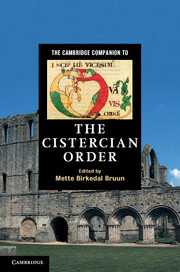Book contents
- Frontmatter
- Contents
- Figures
- Contributors
- Preface
- Abbreviations
- Introduction
- Part I History
- 1 Foundation and twelfth century
- 2 The Cistercian Order 1200–1600
- 3 The Cistercian Order since 1600
- Part II Structure and materiality
- Part III Religious mentality
- Map of Cistercian monasteries
- Primary sources
- Further reading
- Index
- References
2 - The Cistercian Order 1200–1600
from Part I - History
Published online by Cambridge University Press: 05 December 2012
- Frontmatter
- Contents
- Figures
- Contributors
- Preface
- Abbreviations
- Introduction
- Part I History
- 1 Foundation and twelfth century
- 2 The Cistercian Order 1200–1600
- 3 The Cistercian Order since 1600
- Part II Structure and materiality
- Part III Religious mentality
- Map of Cistercian monasteries
- Primary sources
- Further reading
- Index
- References
Summary
In his Exordium Magnum, composed between 1206 and 1221, Conrad of Eberbach saw in the wonderful history of the Cistercian Order an example of the providence of God. During the thirteenth century the Order was greatly admired. The Frankish lords of the new Latin Empire of Constantinople were generous benefactors, though the hope of successful proselytism among the Orthodox proved illusory. Ruling houses often chose Cistercian abbeys as burial places for their dynasties. In 1228 King Louis IX of France founded the Cistercian abbey of Royaumont near one of his castles, for members of the royal family other than the kings themselves. The remains of Pribislav, the first Christian ruler of Pomerania, were translated to the abbey of Doberan by his son Borwin around 1219. Mariensee/Chorin was founded in 1258 as a burial place for the younger line of the Ascanian margraves of Brandenburg. In 1291 King Wenceslas II of Bohemia founded the Cistercian abbey of Zbraslav (Aula Regia) as the necropolis of his dynasty.
Most spectacular was the increase in houses for Cistercian women. ‘The religious movement of women of the Cistercian Order’, wrote Jacques de Vitry, a contemporary, ‘increased to infinity like the stars of heaven.’ Local studies confirm Jacques’s enthusiasm. In 1234, for instance, the archbishop of Cologne approved the foundation of a house of Cistercian nuns at Duissern near Duisburg. It was to be for thirteen nuns, a number which was not to be exceeded. Already in 1237 the archbishop agreed to twenty-five. In 1240, six years after its foundation, there were enough sisters in Duissern for the foundation of a daughter house.
- Type
- Chapter
- Information
- The Cambridge Companion to the Cistercian Order , pp. 38 - 49Publisher: Cambridge University PressPrint publication year: 2012
References
- 2
- Cited by

